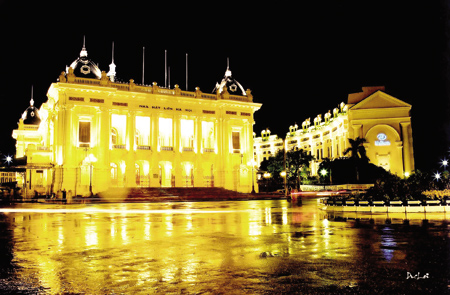Hanoi Opera House was a big French architecture built in the early 20th century. It was constructed between 1901 and 1911.
This place used to be a marsh of Thach Tan and Tay Luong villages in Phuc Lan Canton, Tho Xuong District. In 1899, in a meeting chaired by Richard, the French Ambassador in Hanoi, the Hanoi council proposed Governor Fourier to the built municipal theatre.
The theatre was designed by 2 architects Harlay and Broyer. After revision, the theatre was built on the 7th June 1901 under the supervision of architect Harlay, one of two designers. The main contractors were Travary and Salon.
The construction required 300 workers, 35,000 bamboo stakes were placed and a 90 cm-thick layer of concrete was poured in the swamp to reinforce its foundation. More than 12,000 m3 of materials and nearly 600 tones of steel were used. The building covers an area of 2,600m2 of which the length is 87 m and the width is 30 m. The highest point is 34 m above the pavement. The facade of the theatre is very sizable overlooking the August Revolution Square.
Inside the theatre are a huge stage and a hall with 870 seats. The middle floor has many small rooms for special guests. The middle stair leading to the second floor is a large corridor. Behind the theatre is an administration room. There are 18 makeup chambers, 2 rehearsal rooms, a library and a conference room. The front of the second floor is a splendid mirrored room. The expenditure for the construction was 2 million French francs at that time.
The theatre often held classical art performances such as opera, chamber music and drama to serve French officials of the upper class and wealthy Vietnamese people. The theatre often opened 4 times a week on Tuesday, Thursday, Saturday and Sunday.
Hanoi Opera House has a significant value of history, architecture and existing use. It is a historical witness for the social and cultural development of Hanoi in the French colonial period, a relic of a development period of architecture in Vietnam in the late 19th and early 20th century.



